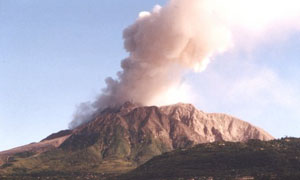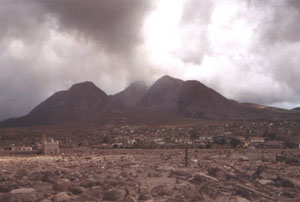Accurate weather forecasts could help predict volcanic eruptions, according to British environmental scientists.
Researchers at the University of East Anglia working with colleagues at the Montserrat Volcano Observatory and the University of Maryland have discovered that intense rainfall can trigger volcanic dome collapse. This leads to a particular type of eruption in which a build-up of molten rock inside the side of the volcano becomes unstable and collapses spewing out lava, toxic gases, and rock.

The Soufrière Hills volcano in Montserrat with pyroclastic flow deposits visible on the left flank
The eruption on the Caribbean island of Montserrat in July last year coincided with the first heavy rainfall in seven months, explains team member Adrian Matthews. Within hours of the rainfall starting the volcanic dome collapsed. Matthews, a meteorologist, leads the research team with UEA volcanologist, Jenni Barclay. The scientists also found that two previous eruptions of the Montserrat volcano, Soufriere Hills, had also been preceded by heavy rainfall.
The researchers point out that one of the most dangerous aspects of volcanic dome collapse is the accompanying surge of searing hot rocks and boulders that are carried at high speed down the mountain on a bed of volcanic gases, the pyroclastic flow. Weather forecasts, the team says, used in conjunction with rainfall records might help make more accurate predictions of imminent volcanic activity and offer people who live in the shadow of active volcanoes an early warning of eruptions.

The devastated Montserrat capital of Plymouth under volcanic debris
Montserrat had seven months with little rain and a period of sustained volcanic dome growth. Once the intense rain set in, it was only a matter of hours before the dome collapsed and pyroclastic flows started. The weather system that brought the rain could be seen in satellite images and was forecast 60 hours before the volcanic activity. The next step is to work out how the rainfall triggers the eruption, it may be the water being turned to steam and building up inside the dome, like a pressure cooker, adds Matthews.
Further reading
Geophys. Res. Lett., 29(13) (2002)
http://dx.doi.org/10.1029/2002GL014863
Soufriere Hills
http://www.geo.mtu.edu/volcanoes/west.indies/soufriere/
Suggested searches
Soufriere Hills volcano
Pyroclastic flows
Volcanoes